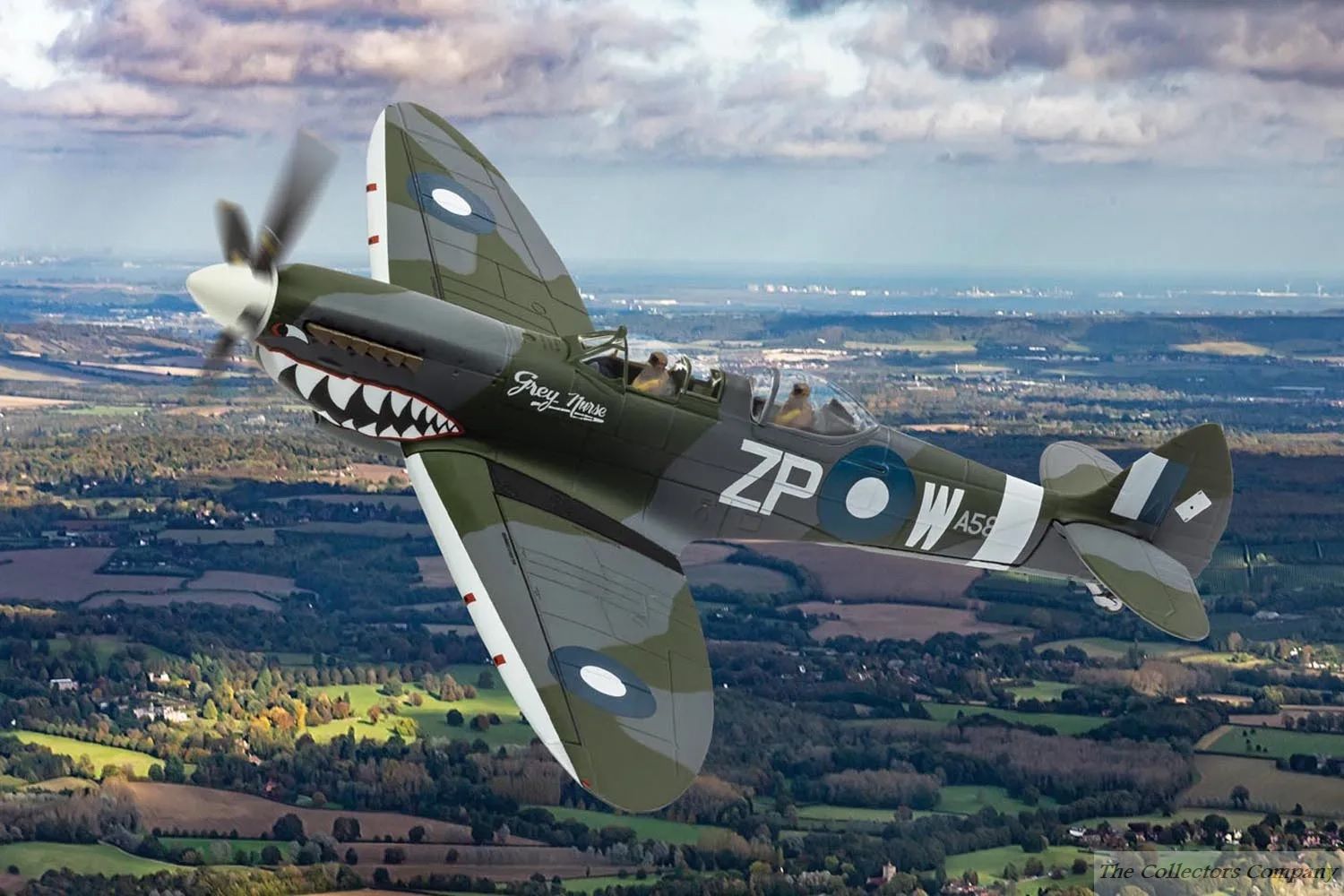Corgi Supermarine Spitfire T.9 TE308 'Grey Nurse' AA29201
Supermarine Spitfire T.9 TE308 (G-AWGB) Finished as A58-606 ‘Grey Nurse’ Sharkmouth, operated by Biggin Hill Heritage Hangar.
As one of the most successful fighter aircraft of the Second World War and one which was produced in huge numbers, it can be a little surprising to learn that the Supermarine Spitfire was not produced in a two seat training variant during the war, meaning that pilots converting to this awesome machine would be making their first flight in the Spitfire as their first solo. The Vickers Supermarine company did propose the development of a two seat variant of the Spitfire to Air Ministry officials as far back as 1941, but as there was no official support for the project at the time, they simply returned to further development of single engined fighters.
Once the war had ended, stories of unofficially modified two seat Spitfire projects started to circulate, with the ones produced by the Soviet Air Force being perhaps the most significant. Britain would eventually supply Russia with more than 1000 Spitfires and it was discovered that they actually converted several Spitfires to two seat configuration, however, rather than moving the front cockpit slightly forward as Vickers Supermarine would later do, the Russians elected to simply add a second cockpit behind the existing one, using a narrower section of the fuselage. Making these aircraft extremely distinctive, this also must have also created a rather claustrophobic working environment for the second pilot.
With this information in hand, Vickers Supermarine revived their interest in producing a two seat Spitfire as a private venture and in 1946, selected a Spitfire Mk.VIII airframe as their donor aircraft. In fact, one of the most interesting facts about the two seat Spitfire variant is that there is no such thing as a new-build Spitfire T.9 trainer, because every single example was originally manufactured as a single seat fighter.
Something of a post war phenomenon, the two seat Spitfire did attract several military operators over the years, including the Irish Air Corps, however, it is during the warbird restoration era and more specifically over the past two decades that the popularity of ‘Spitfires made for two’ has really become established. As arguably the most famous aircraft of all time, the ability to boast that you had flown in a Spitfire used to be the preserve of talented and extremely fortunate pilots, however, as they now had the opportunity to carry a passenger, the chance to fly in a Spitfire was now open to anyone and there has been no end of people desperate to have a Spitfire flying experience.
Nowadays, offering Spitfire experience flights has become an extremely lucrative business, to a point where only a few years ago, almost every Spitfire under restoration was being converted to T.9 or two seat Spitfire standard. These aircraft are now much loved in their own right, regularly appearing at Airshows, in addition to operating in all but the poorest weather conditions, taking its latest lucky passenger on their Spitfire experience flight. These Spitfires made for two are maintaining and even enhancing the legacy of this magnificent aeroplane, bringing R.J Mitchell’s classic fighter to the attention of a new generation of Spitfire aficionados.
Supermarine Spitfire TE307 was originally constructed as a Mk.IXe fighter variant in 1945, but due the end of the war in Europe, was immediately placed in storage, where she would remain for the next five years. She was then selected as a conversion airframe to T.9 trainer standard, initially earmarked for service with the Egyptian Air Force, but when this sale fell through, embarked on a service career flying with the Irish Air Corps. Following retirement and disposal, she would go on to be used during the filming of the famous move 'The Battle of Britain', before moving into private ownership and periods spent with different owners in France, Canada and the US over the next few decades. She would later be purchased by Warbird Experiences at Biggin Hill and returned to British skies at that time wearing the famous standard RAF wartime day fighter scheme, however, she was about to take on a very different persona.
In a development which saw this aircraft become one of the most distinctive airworthy Spitfires in the world today, TE307 was given a smart new scheme in honour of the fighters flown by the men of No.457 Squadron Royal Australian Air Force during WWII. With each of their aircraft benefitting from the application of sinister looking shark mouths under the engine cowling, the unit was known as the 'Grey Nurse' Squadron and Spitfire TE307 now carries the registration A58-606 and the codes ZP-W in honour of Squadron Leader Bruce Watson, who flew with this unit.


